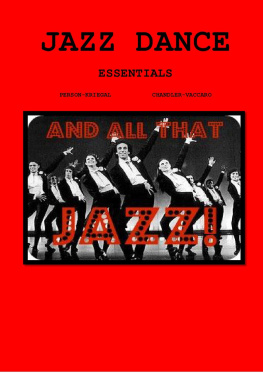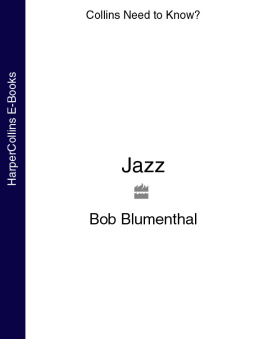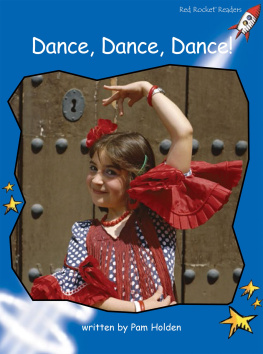JAZZ DANCE TODAYESSENTIALS

Lorraine Person-Kriegel Kimberly Chandler-Vaccaro
Total Health Publications
Oslo, Norway
Copyright 2015
 MEET THE AUTHORS
MEET THE AUTHORS
L orraine Kriegel is a retired professor and choreographer interested in dance techniques. She has been a high level professional performer as well as the creative director for a number of dance companies.
She is currently using multimedia imaging technology to explore the 19th century ballet of the Paris Opera and the 20th century jazz of Luigi.

Dr. Kim Chandler Vaccaro is the director of the Rider University/ Princeton Ballet School Dance program and is on the faculties of both institutions. She teaches ballet, creative movement, Pilates, dance history and a number of other subjects. She is also a choreographer and has written and edited several books on the various forms and functions of dance.
Kimberly has a new book on modern dance and movement meditation which is now available. CoMBo ( Co nditioning for M ind Bo dy) Contemplative Movement for Holistic Health is a conditioning program for mindbody that develops focus, balance, coordination, strength, flexibility, confidence and joy. CoMBo conditions both the mind and body. It begins with a contemplative movement practice that takes the focus fully inward. It is heavily illustrated and contains numerous videos in its ebook version.
TABLE OF CONTENTS
M EET THE AUTHORS
Preface
Introduction
CHAPTER 1
Preparing for the
Jazz Dance Class
Knowing What You Want to Achieve and How to Achieve It
What to Wear and Why
Understanding the Necessity of Training
Terminology
Listening to Music in Class
Getting Prepared Mentally
Psycho-neuromuscular Theory
Relaxation
Getting Prepared Physically
Your Personal Warm-up
What's Missing from a Jazz Dance Class
CHAPTER 2 Jazz Dance Technique
How Today's Jazz Class Developed and Why
Basic Dance Technique
Alignment
Turnout or Outward Rotation
Parallel and Turned-In Positions
Releve
Transference of Weight
Vocabulary
Jazz Walks
Jazz Turns
Elevations
Extensions
Elevations
Pas de bourree
Contractions
CHAPTER 3
The Jazz Dance Classa Model
Physical Training
Style Training
General Warm-up (Large Muscle Groups)
Proper Alignment. A Review
Fine Tuning (Smaller Muscle Groups)
Strengthening Exercises
Flexibility Exercises
Endurance Conditioning
Isolations
Short Combinations
Long Combinations
Cool-down
Reverence
CHAPTER 4
Basic Nutritional and Cardiorespiratory Conditioning
Cardiorespiratory Conditioning
CHAPTER 5
Supplemental Strength Training for the Dancer
Upper Body
Chapter 6
Supplemental Flexibility
Training for the Dancer
Supplemental Flexibility Training
Warm-up
Relaxation
Duration
Specificity
CHAPTER 7
Discipline and Training Schedules
Discipline and Training Schedules
Variety in Training
Body Therapies
Alexander Technique
Bartlnleff Fundamentals
Pilates Method
Ideokinesi
Feldenkrais
Massage
CHAPTER 8
What Is Jazz Dance?
Jazz Energy: The Kinetic Push
The Jazz Culture
ChecklistWhat the Experts Say
The Jazz Culture
Individual Risk in a Collective Context
European/African influences on American Jazz
Music and Movement in the Black Church
Social Dance/Theatrical Dance
1900-1950
Latin American Influences
Rap and Hip-hop
Aerobic Dance
Dance Synthesis: Ballet/Modern/Jazz
Jazz Dance's Global Future
CHAPTER 9
Jazz Dance Choreography
Choreography
Choreographer
Context
Creative Team
Choreographing
Jazz Choreography
Movement Shaped into Meaning
Choreography: Movement Shaped Into Meaning.
Developing Jazz Movement
Shaping with the Tools of Choreography
Staging
Dynamics
Creating Meaning: The Creative Process
Preparation
CHAPTER 10
The Performance
Jazz Dance: A Performing Art
Projection
Understanding the Dance
Honesty
Concentration
Authority
Coping with Stage Fright
APPENDIX A Muscle Chart
Appendix B Vitamin-Mineral Chart
APPENDIX C
Calorie expenditure from various activities
Calorie/Activity Chart 3500 calories = 1 pound
APPENDIX D
Dance Publications
APPENDIX E
Dance Wear
APPENDIX F
Conventions and Competition
APPENDIX G
Preparation Checklists
THE MODELS
Preface
J azz dance is a nonverbal art form traditionally passed from teacher to student in a physical way. In preparing a book about jazz dancein effect making the nonverbal verbalwe have tried to integrate written information from dance theorists, historians, and kinesiologists with dance information from teachers, choreographers, producers, and dancers. Our goal was to present an accurate picture of jazz dance today in the context of its tradition supported by the latest in dance science research. Our purpose in bringing this information together was to supplement the more emotional and immediate experience of jazz dance classes with a conceptual structure that will enrich the studio experience for the students.
This past decade has seen a surge in the theoretical information written on dance. Dance as an art form is being researched, analyzed, and studied in terms of both history and creative processes, while dance kinesiology, the science of dance movement, is a rapidly expanding field. Each area offers its own insights into the dance arena, and dancers today have the advantage of applying this information to their daily training.
Jazz Dance Today Essentials includes the findings of current research. It is an organizational framework based on the principles of dance fitness, allowing the student and teacher to concentrate on the art. On the surface, it will appear not unlike a traditional class, yet the exercises have been ordered and conceived to provide a balance of strength and flexibility, endurance conditioning, and neuromuscular coordination. The class is broken down into elements, each defined by current information on dance kinesiology.
Consideration is given to the idea of dance as an entity in itself and as a mind-body-soul application. We believe that intention, expressiveness, motivation, performance quality, musicality, and communication within the art of dance are foremost. Our framework allows students to work on these attributes knowing they are attending to physical wellness. In an attempt to bypass some of the injuries that have plagued dancers for so long, the framework is a strategy that emphasizes student safety in a comprehensive dance experience. Jazz Dance Today provides a visual tool to examine a dancer's training. It is meant as a practical guide that can free class time for dancing.
Jazz dance is a freedom-loving, movement-loving tradition. Each young jazz dancer who receives this gift of expression is free to play with it and shape it to his or her own world view. Therefore, jazz dance today is not jazz dance yesterday or jazz dance tomorrow.
Next page







 MEET THE AUTHORS
MEET THE AUTHORS